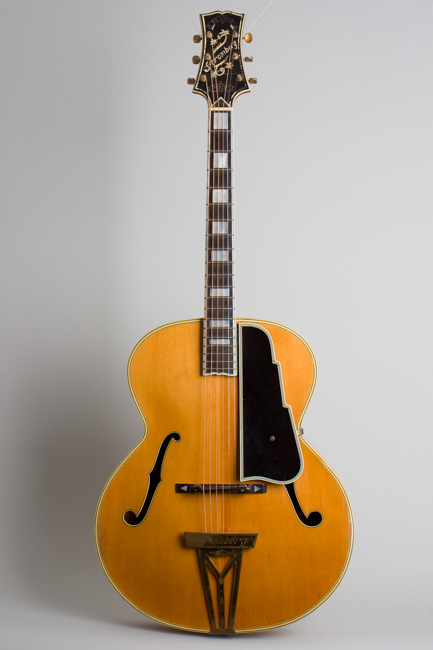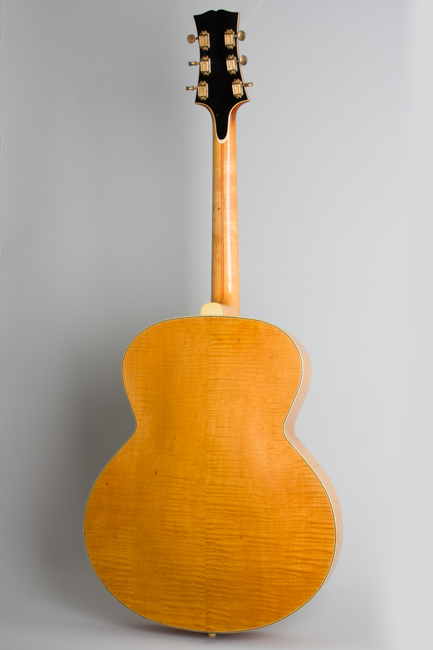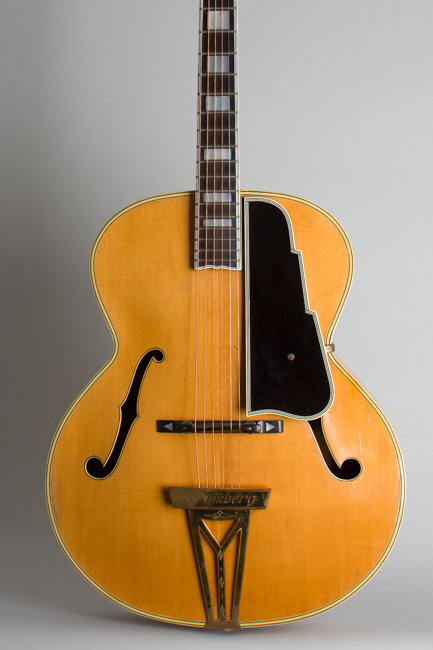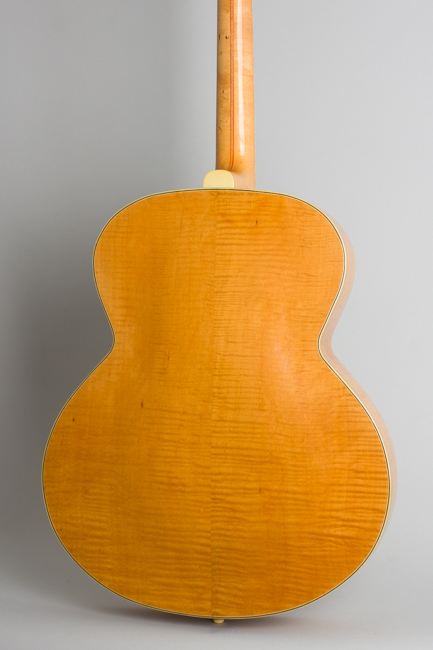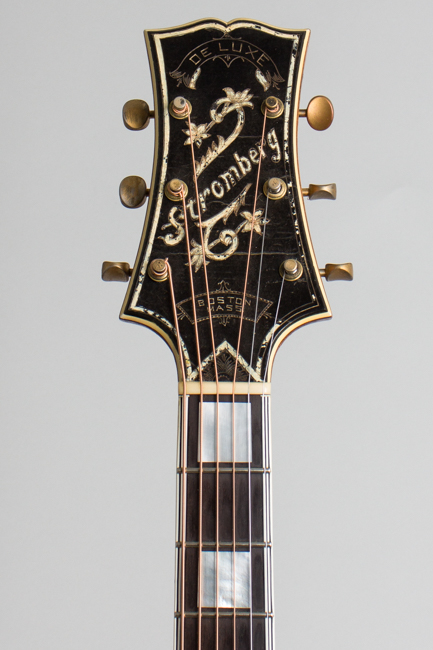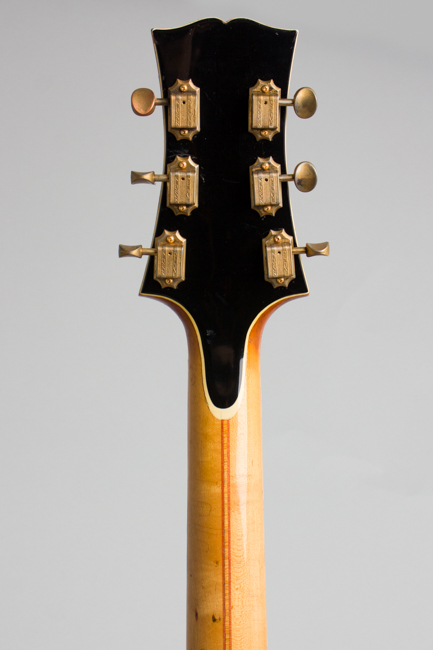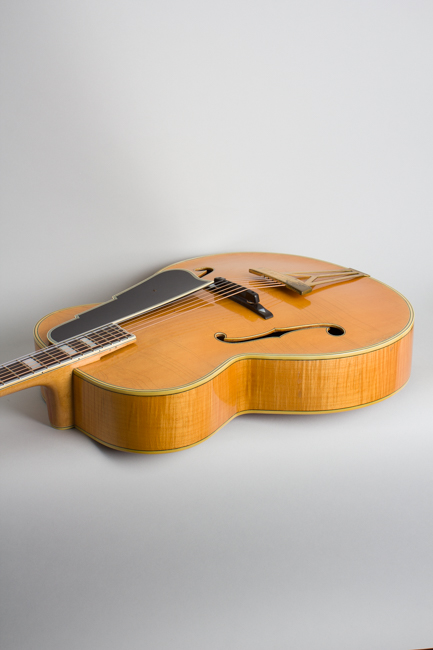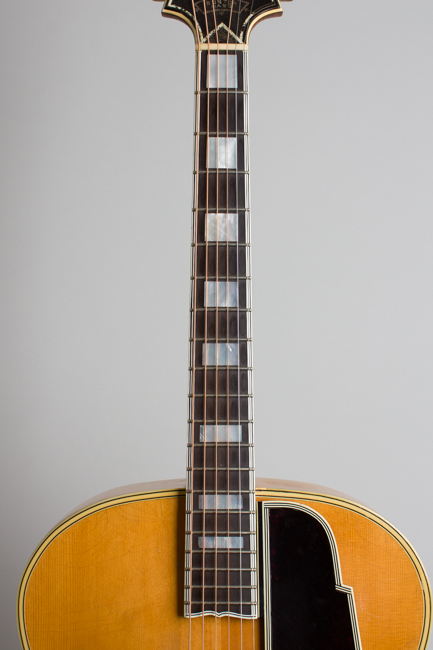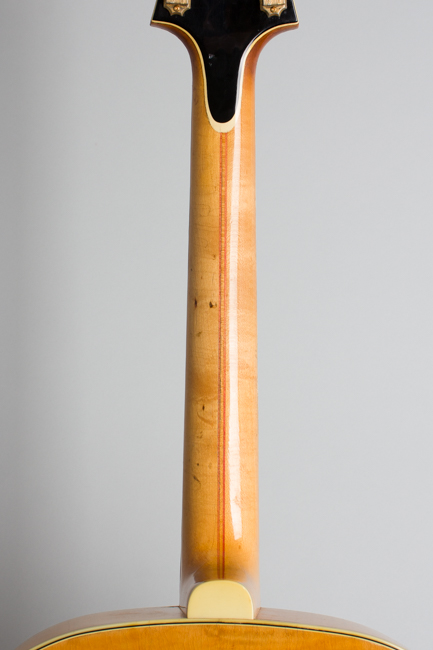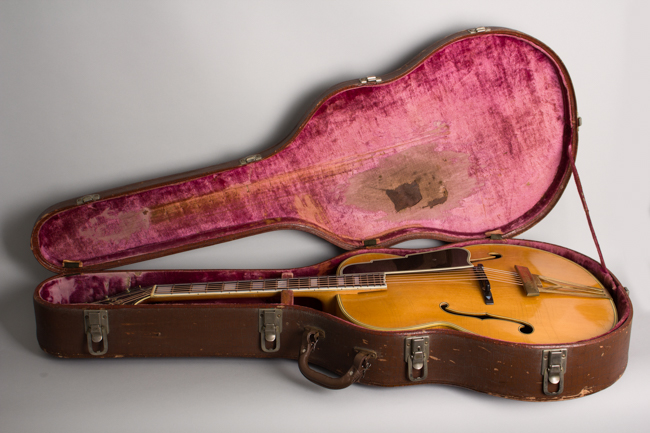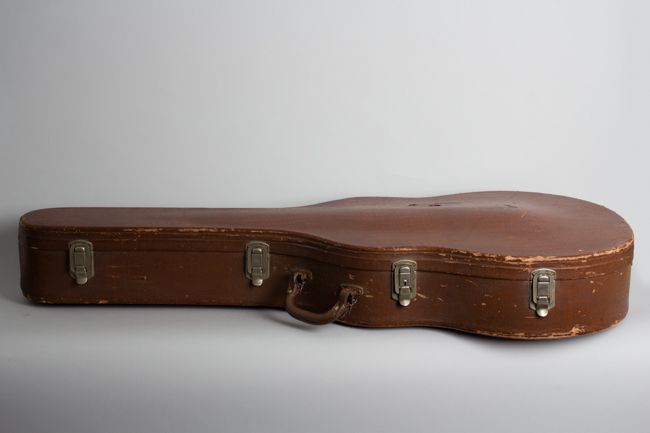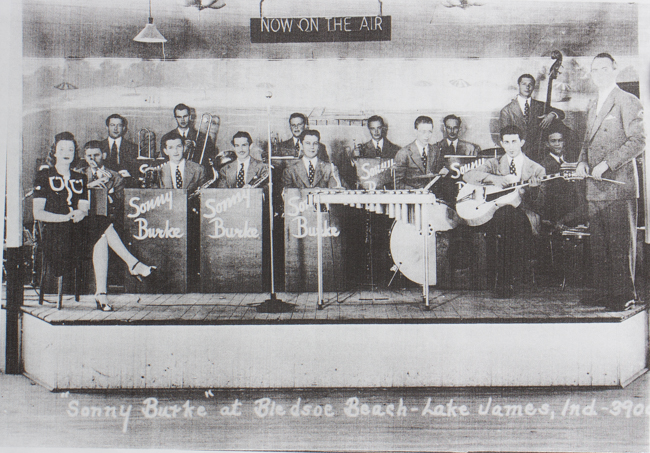Stromberg Deluxe Arch Top Acoustic Guitar (1940)
This item has been sold.
Item # 11175
Prices subject to change without notice.
Stromberg Deluxe Model Arch Top Acoustic Guitar (1940), made in Boston, Mass., natural lacquer finish, flame maple back and sides, spruce top, laminated maple neck with ebony fingerboard, original brown hard shell case.
This rare, beautiful and very well-preserved carved-top guitar is the product of the father-and-son team of Charles and Elmer Stromberg of Boston, revered names in the annals of 20th century arch-top guitars. Elmer, the son, was the primary guitar artisan; some of his handmade creations are considered among the finest of all. In the 1940s his Master 400 with a huge 19" wide body and single diagonal top brace was hailed as the most powerful of acoustic big-band guitars, able to drive an orchestra better than any of its rivals. In the early 1940s both the Ellington and Basie big bands rode on the rhythm of a Stromberg.
"A Modern Instrument For All requirements" was the headline of the Stromberg brochure. In 1940 the requirement at the top of the professional guitar pantheon was the orchestra arch top, the prestige market all guitar makers (even Martin, at the time) aimed for. The Strombergs built drums and banjos during the 1910s and '20s; by the early '30s their attentions turned to F-hole guitars. Their early efforts with heavily braced tops formed into an arch instead of carved and laminate backs did not seriously rival Gibson, Epiphone or D'Angelico. The transition to high quality carved instruments with a single diagonal top brace took place around 1939 when Elmer began to create guitars now considered the cream of the Stromberg crop.
This blonde 1940 Deluxe model is Stromberg's L-5 equivalent, in the same class as Epiphone's Deluxe and the D'Angelico Excel. The Stromberg brochure offers "This instrument is highly recommended by many of the leading guitarists throughout the nation". Beyond cosmetics what really distinguished Elmer's design is the unique single-brace top design, which imparts an extra power and punch to the sound. This guitar was built as Stromberg's reputation was flowering; it bears serial number 511 dating to late 1940. Freddie Guy's Master 400 known to have been acquired in 1940 had serial number 499; the personal history accompanying this instrument states it was also completed that year.
The beautiful flame maple body is 17 1/2 inches wide, slightly larger than competing models. The top has 5-ply binding with a thick center strip, the back is triple bound. The top is carved spruce, fairly thin with that one long trademark brace. The back and sides have a tight grain tiger maple figure. The 5-piece laminated neck has a multi-bound ebony fingerboard with pearl block inlay. The finish is a lovely ambered natural lacquer, which is both rarer and more attractive than the Stromberg's dark orangey sunburst finish.
The unique headstock really shows the Strombergs' detail artistry with delicate engraving on the laminated headstock face, the legacy of decades of banjo making. This festival of cut-through Celluloid is dressed away at the edge to appear multi-bound, beautifully designed and flawlessly executed. The floral engraved pattern on the face sets off the diagonal "Stromberg" logo with "Boston, Mass." and "Deluxe" in smaller banner motifs. The tuners are gold Kluson Deluxes, of later vintage than the guitar.
The pickguard is a multi-bound heavy celluloid piece with distinctly deco lines; this was fitted by Stromberg in 1954 to replace a decaying original and has a small spacer bar ion the inner edge to allow a DeArmond pickup to be fitted. The tailpiece is a large gold-plated affair with an engraved "Stromberg" logo on the crossbar and some attendant filigree. The neck has a slim, comfortable round contour narrower than typical Gibsons of the period.
The interior label is a re-purposed mailing label, with "Stromberg 40 Hanover Street Boston Mass" across the top. Hand typed above is "Made By" and in the address box: "This guitar is guaranteed for a life-time to the original purchaser, if used properly" along with the serial number. One wonders what a player would have had to do to have Charles and Elmer refuse them service due to "improper use"!
All Stromberg guitars are rare; older published estimates run around 600 made, but recent analysis shows the serial numbers appear to start at 300, so the total is likely less than 350 guitars ever built, likely 150 or fewer with a carved, single brace top. Each is a unique gem. This 17 1/2" Deluxe is earlier to handle than the 19" Master 400 but a far superior instrument to the earlier 16" and 17" models that lack a carved top. This blonde beauty is the top 1940 Stromberg model that was NOT 19" wide, a size some players find awkward. The sound is very powerful but sweeter than many larger models; it has more richness to the tone than many Strombergs are credited with and is a worthy challenger to any pre-war L-5, Epiphone Deluxe or (dare we say it?) D'Angelico Excel. Even many experienced players have never encountered a genuine 1940s Stromberg; we find this one enchanting and a pure pleasure to play.
The guitar comes with an amazing set of mimeographed notes clippings detailing its history, something now rarely found. It was originally ordered by John Giordano (who performed as John Jordan and Jidge Jordan) and played professionally from 1940 on, notably with the Sonny Burke orchestra and the Sam Donohue orchestra and combo. Detailed notes of recordings it was used on are included, as are a copy of a letter referencing him written by Elmer Stromberg, along with a mimeo'd clipping from Stromberg's catalog. Giordano's wife notes he played this guitar exclusively from 1940 on, except for three months in 1954 when it was returned to Stromberg for service.
Overall length is 42 1/2 in. (108 cm.), 17 1/2 in. (44.4 cm.) wide at lower bout, and 3 1/2 in. (8.9 cm.) in depth, measured at side of rim. Scale length is 24 3/4 in. (629 mm.). Width of nut is 1 11/16 in. (43 mm.).
This very rare guitar is very well preserved for being a professionally used instrument over 80 years old. The natural lacquer finish shows checking overall, mostly to the top with some scuffs, scratches, dings and dents but still shines in a truly glorious blonde! The top has some odd scratch marks just at the apex of each lower bout and a few random scratches and dings. There a few dinks into the back of the neck but the playing surface is mostly relatively clean; the celluloid back strapping is feelably lifted just a bit on the treble side. The celluloid headstock facing has lost some of the paint from the decorative elements. It shows some light shrinkage with fine check lines and puckering to the surface but is not crumbling as many are.
Most fittings on the guitar appear original, or the work of the original maker. As the guitar is documented as having gone back to the Stromberg workshop in 1954, some things were certainly re-done at that time. The currently fitted ebony bridge is later, a handmade piece by modern master John Monteleone. The Stromberg rosewood bridge is in the case pocket, and is the 1954-era style. The pickguard is also by Stromberg, similarly of the larger 1950s Deco pattern with an elegant spaced fitted to allow a DeArmond pickup to be fitted without notching the guard. The small "vampire bites" on the side of the fingerboard and faint felt mark on the top confirm one was once in place. The original tailpiece shows some plating corrosion and loss. Mostly on the upper corner of the bar.
The only other later alteration we can detect is the tuners; currently fitted is a gold-plated set marked Kluson Deluxe but of a style made in the last 25 years or so. In the case are a set of nickel Klusons from the mid-1950s, likely added to the guitar in 1954. The celluloid plate underneath then shows only marks from these Klusons, so was likely either polished out or replaced at the time. The photographic evidence provided confirms the guitar has always been finished natural; it is possible Elmer refinished the instrument when it was re-conditioned in 1954 but in either case this is a totally authentic Stromberg finish.
The frets are recent and in excellent shape; we believe the bone nut has also been replaced. The neck is quite straight, the angle is excellent and this is a truly fine-playing guitar. The sound is sublime; clean and powerful but not strident and with considerable dynamic range. This 17 1/2" Stromberg belies their sometime reputation as simple rhythm drivers offering a more complex and rich sound than they are often credited with. What appears to be the original Geib hard shell case has some general wear and a large "celluloid burn" spot under the lid but is structurally fine. This is a fantastic instrument with an amazingly well-documented provenance from a working swing-era player, a true playable piece of history. Overall Excellent - Condition.
This rare, beautiful and very well-preserved carved-top guitar is the product of the father-and-son team of Charles and Elmer Stromberg of Boston, revered names in the annals of 20th century arch-top guitars. Elmer, the son, was the primary guitar artisan; some of his handmade creations are considered among the finest of all. In the 1940s his Master 400 with a huge 19" wide body and single diagonal top brace was hailed as the most powerful of acoustic big-band guitars, able to drive an orchestra better than any of its rivals. In the early 1940s both the Ellington and Basie big bands rode on the rhythm of a Stromberg.
"A Modern Instrument For All requirements" was the headline of the Stromberg brochure. In 1940 the requirement at the top of the professional guitar pantheon was the orchestra arch top, the prestige market all guitar makers (even Martin, at the time) aimed for. The Strombergs built drums and banjos during the 1910s and '20s; by the early '30s their attentions turned to F-hole guitars. Their early efforts with heavily braced tops formed into an arch instead of carved and laminate backs did not seriously rival Gibson, Epiphone or D'Angelico. The transition to high quality carved instruments with a single diagonal top brace took place around 1939 when Elmer began to create guitars now considered the cream of the Stromberg crop.
This blonde 1940 Deluxe model is Stromberg's L-5 equivalent, in the same class as Epiphone's Deluxe and the D'Angelico Excel. The Stromberg brochure offers "This instrument is highly recommended by many of the leading guitarists throughout the nation". Beyond cosmetics what really distinguished Elmer's design is the unique single-brace top design, which imparts an extra power and punch to the sound. This guitar was built as Stromberg's reputation was flowering; it bears serial number 511 dating to late 1940. Freddie Guy's Master 400 known to have been acquired in 1940 had serial number 499; the personal history accompanying this instrument states it was also completed that year.
The beautiful flame maple body is 17 1/2 inches wide, slightly larger than competing models. The top has 5-ply binding with a thick center strip, the back is triple bound. The top is carved spruce, fairly thin with that one long trademark brace. The back and sides have a tight grain tiger maple figure. The 5-piece laminated neck has a multi-bound ebony fingerboard with pearl block inlay. The finish is a lovely ambered natural lacquer, which is both rarer and more attractive than the Stromberg's dark orangey sunburst finish.
The unique headstock really shows the Strombergs' detail artistry with delicate engraving on the laminated headstock face, the legacy of decades of banjo making. This festival of cut-through Celluloid is dressed away at the edge to appear multi-bound, beautifully designed and flawlessly executed. The floral engraved pattern on the face sets off the diagonal "Stromberg" logo with "Boston, Mass." and "Deluxe" in smaller banner motifs. The tuners are gold Kluson Deluxes, of later vintage than the guitar.
The pickguard is a multi-bound heavy celluloid piece with distinctly deco lines; this was fitted by Stromberg in 1954 to replace a decaying original and has a small spacer bar ion the inner edge to allow a DeArmond pickup to be fitted. The tailpiece is a large gold-plated affair with an engraved "Stromberg" logo on the crossbar and some attendant filigree. The neck has a slim, comfortable round contour narrower than typical Gibsons of the period.
The interior label is a re-purposed mailing label, with "Stromberg 40 Hanover Street Boston Mass" across the top. Hand typed above is "Made By" and in the address box: "This guitar is guaranteed for a life-time to the original purchaser, if used properly" along with the serial number. One wonders what a player would have had to do to have Charles and Elmer refuse them service due to "improper use"!
All Stromberg guitars are rare; older published estimates run around 600 made, but recent analysis shows the serial numbers appear to start at 300, so the total is likely less than 350 guitars ever built, likely 150 or fewer with a carved, single brace top. Each is a unique gem. This 17 1/2" Deluxe is earlier to handle than the 19" Master 400 but a far superior instrument to the earlier 16" and 17" models that lack a carved top. This blonde beauty is the top 1940 Stromberg model that was NOT 19" wide, a size some players find awkward. The sound is very powerful but sweeter than many larger models; it has more richness to the tone than many Strombergs are credited with and is a worthy challenger to any pre-war L-5, Epiphone Deluxe or (dare we say it?) D'Angelico Excel. Even many experienced players have never encountered a genuine 1940s Stromberg; we find this one enchanting and a pure pleasure to play.
The guitar comes with an amazing set of mimeographed notes clippings detailing its history, something now rarely found. It was originally ordered by John Giordano (who performed as John Jordan and Jidge Jordan) and played professionally from 1940 on, notably with the Sonny Burke orchestra and the Sam Donohue orchestra and combo. Detailed notes of recordings it was used on are included, as are a copy of a letter referencing him written by Elmer Stromberg, along with a mimeo'd clipping from Stromberg's catalog. Giordano's wife notes he played this guitar exclusively from 1940 on, except for three months in 1954 when it was returned to Stromberg for service.
Overall length is 42 1/2 in. (108 cm.), 17 1/2 in. (44.4 cm.) wide at lower bout, and 3 1/2 in. (8.9 cm.) in depth, measured at side of rim. Scale length is 24 3/4 in. (629 mm.). Width of nut is 1 11/16 in. (43 mm.).
This very rare guitar is very well preserved for being a professionally used instrument over 80 years old. The natural lacquer finish shows checking overall, mostly to the top with some scuffs, scratches, dings and dents but still shines in a truly glorious blonde! The top has some odd scratch marks just at the apex of each lower bout and a few random scratches and dings. There a few dinks into the back of the neck but the playing surface is mostly relatively clean; the celluloid back strapping is feelably lifted just a bit on the treble side. The celluloid headstock facing has lost some of the paint from the decorative elements. It shows some light shrinkage with fine check lines and puckering to the surface but is not crumbling as many are.
Most fittings on the guitar appear original, or the work of the original maker. As the guitar is documented as having gone back to the Stromberg workshop in 1954, some things were certainly re-done at that time. The currently fitted ebony bridge is later, a handmade piece by modern master John Monteleone. The Stromberg rosewood bridge is in the case pocket, and is the 1954-era style. The pickguard is also by Stromberg, similarly of the larger 1950s Deco pattern with an elegant spaced fitted to allow a DeArmond pickup to be fitted without notching the guard. The small "vampire bites" on the side of the fingerboard and faint felt mark on the top confirm one was once in place. The original tailpiece shows some plating corrosion and loss. Mostly on the upper corner of the bar.
The only other later alteration we can detect is the tuners; currently fitted is a gold-plated set marked Kluson Deluxe but of a style made in the last 25 years or so. In the case are a set of nickel Klusons from the mid-1950s, likely added to the guitar in 1954. The celluloid plate underneath then shows only marks from these Klusons, so was likely either polished out or replaced at the time. The photographic evidence provided confirms the guitar has always been finished natural; it is possible Elmer refinished the instrument when it was re-conditioned in 1954 but in either case this is a totally authentic Stromberg finish.
The frets are recent and in excellent shape; we believe the bone nut has also been replaced. The neck is quite straight, the angle is excellent and this is a truly fine-playing guitar. The sound is sublime; clean and powerful but not strident and with considerable dynamic range. This 17 1/2" Stromberg belies their sometime reputation as simple rhythm drivers offering a more complex and rich sound than they are often credited with. What appears to be the original Geib hard shell case has some general wear and a large "celluloid burn" spot under the lid but is structurally fine. This is a fantastic instrument with an amazingly well-documented provenance from a working swing-era player, a true playable piece of history. Overall Excellent - Condition.
